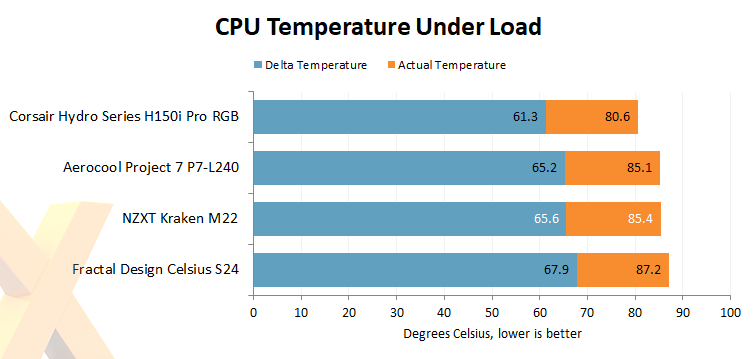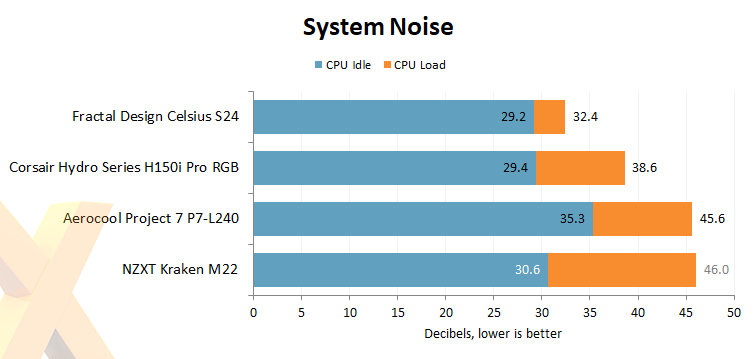Test Methodology and Performance
Comparison Coolers |
|||||
|---|---|---|---|---|---|
| Category | Model | HEXUS Review | Reviewed Price | Warranty | Product Page |
| Liquid | Aerocool Project 7 P7-L240 | February 2018 | £100 | 2 Years | aerocool.com.tw |
| Corsair Hydro Series H150i Pro RGB | January 2018 | £165 | 5 Years | corsair.com | |
| Fractal Design Celsius S24 | May 2017 | £105 | 5 Years | fractaldesign.com | |
| NZXT Kraken M22 | March 2018 | £90 | 3 Years | nzxt.com | |
HEXUS CPU Cooler Test Bench |
||
|---|---|---|
| Hardware Components | Product Page | |
| Processor | Intel Core i7-8700K (overclocked to 4.8GHz) | intel.com |
| Motherboard | Asus ROG Maximus X Hero | asus.com |
| Graphics Card | MSI GeForce GTX 1080 Ti Gaming X Trio | msi.com |
| Memory | G.Skill Trident Z 32GB (2x16GB) DDR4-3200 | gskill.com |
| Power Supply | be quiet! Dark Power Pro 11 1,000W | bequiet.com |
| Primary Storage | 256GB WD Black PCIe SSD | wdc.com |
| Secondary Storage | 1TB Crucial MX300 SATA SSD | crucial.com |
| Chassis | be quiet! Dark Base 700 | bequiet.com |
| Monitor | iiyama ProLite X4071UHSU-B1 | iiyama.com |
| Operating system | Windows 10 Pro | microsoft.com |
Benchmark Process
Our test platform has been refreshed for 2018 and now includes a hexa-core Intel Core i7-8700K processor overclocked using 1.225v to 4.8GHz across all cores. The 12-thread chip is paired to 32GB of dual-channel G.Skill Trident Z DDR4 memory set to run at 3,200MHz using the built-in XMP profile.
To get a feel for how the coolers compare, CPU temperature is logged while a large 4K video clip is encoded in multiple passes using the freeware HandBrake utility. The workload tasks all available threads for a prolonged period and, in order to provide a stabilised reading, we then calculate the average temperature across all cores from the last five minutes of encoding.
Actual CPU temperature is recorded and we also graph the delta temperature - that's CPU temperature minus ambient temperature. Last but not least, to give you an idea of cooler acoustics, we use a PCE-318 noise meter to measure overall system noise in both idle and load states.
Notes
Our be quiet! Dark Base 700 chassis is set to run with its two stock SilentWings 3 PWM fans - a 140mm front intake and a 140mm rear exhaust - both of which are set to low speed (setting 1) via the integrated fan hub. All CPU cooler fans are set to a 'silent' profile from within the Asus BIOS, and when testing liquid coolers the pump is connected to the motherboard's dedicated water-pump header.
When a radiator is used, it is installed in the roof of the chassis and any bundled fans are configured to push air through the radiator and out of the enclosure.
Performance

Our 2018 test platform is far more demanding than the last, and half-a-dozen cores flying along at 4.8GHz generate plenty of heat for high-end coolers to attempt to deal with.
We're pleasantly surprised to see NZXT's M22, the smallest radiator on show, holding its own against the 240mm competitors. The cooler must be liking the front-to-back airflow in our be quiet! chassis and is certain to be an improvement over just about any reference cooler, but there's more to the results than first meets the eye...

A 120mm radiator can tame our overclocked Core i7 chip, but doing so requires fan speed to increase to such an extent that noise becomes clearly evident. Kraken M22 is very quiet when idle and the pump can barely be heard, however a larger radiator can shift the under-load heat while making noticeably less noise.









